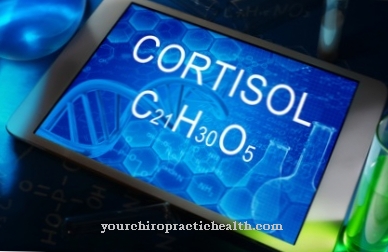The Pseudoxanthoma elasticum (PXE) is a rare hereditary disease also known as Grönblad-Strandberg syndrome. It mainly affects the skin, eyes and blood vessels.
What is pseudoxanthoma elasticum?

© Anchalee - stock.adobe.com
The illness Pseudoxanthoma elasticum will also be Elastorrhexis generalista or Grönblad-Strandberg syndrome called. It is a hereditary disease. The elastic fibers of the connective tissue are affected. The Grönblad-Strandberg syndrome manifests itself in the tissue of the skin, in the vessels, in the cardiovascular system and in the gastrointestinal tract.
Often the eyes are also involved. Around 1000 people across Germany are affected by the disease. The course of the disease, however, is very different and not every person affected shows all symptoms. In addition, the diagnosis is often difficult, so that scientists assume a high number of undetected PXE cases.
causes
Pseudoxanthoma elasticum is inherited as an autosomal recessive trait. The defective allele must therefore be present on both homologous chromosomes for the disease to break out. The mutation is found on chromosome 16. It affects a so-called transmembrane ATP-binding transporter.
Due to this genetic defect, more calcium is stored in the elastic fibers of the connective tissue. This makes the fibers brittle and breaks them into short pieces. The changes caused by this are usually first visible on the neck. The disease progresses slowly, however, so that the entire body can be affected later.
Symptoms, ailments & signs
The first symptoms of Grönblad-Strandberg syndrome usually appear on the neck, the crooks of the elbows, the torso and in the region around the navel. But the armpits, the flexors of the large joints, groin, hollow of the knee, rectum or vagina can also be affected. The skin changes are usually arranged symmetrically and blurred.
The skin surface is yellowish in color and knotty. Prominent skin folds develop. These are especially visible when the skin is stretched. Yellowish skin changes also appear on the oral mucosa. Since the elastic fibers of the connective tissue are affected in the disease, the manifestations are also found on the arteries of the elastic type. The large arteries in particular are of this type.
Arteriosclerosis occurs very early in the patient. There is a risk of massive bleeding in the gastrointestinal tract, lungs, urogenital region, brain and heart. The calcifications not only make the arteries porous, they also narrow. The narrowing affects not only the major arteries but all arterial blood vessels in the body.
The narrowing of the leg arteries causes peripheral arterial disease with pain when walking or even pain at rest. Patients with pseudoxanthoma elasticum also suffer from high blood pressure significantly more often than healthy people.
The fundus of the eye shows dark stripes around the papilla. These striped changes are also known as android streaks. They are probably the result of bleeding. In the course of the disease, bleeding of the retina occurs more and more frequently. Between the ages of 30 and 40, the patient's vision deteriorates significantly. This process can continue until blindness.
Diagnosis & course of disease
Since the disease is very rare, very few doctors think of PXE when the first skin symptoms appear. However, if it is suspected, a skin biopsy is usually performed. In histopathology, the removed elastic connective tissue appears lumpy and fragmented. Calcium salts are found between normal collagenous fibers. However, a clear diagnosis is not always possible on the basis of the skin preparation.
Changes in the area of scars and actinic elastosis must be excluded from the differential diagnosis. Molecular diagnostics may therefore be necessary. The mutation in chromosome 16 can be determined in a mutation analysis in the ABCC6 gene.
Complications
First and foremost, this disease causes various skin complaints and, above all, skin changes. Those affected suffer from itching or a rash. Especially in the face or in other visible parts of the body, these changes can be very unpleasant and lead to inferiority complexes or to a significantly reduced self-esteem.
In many cases, this disease also causes symptoms in the region of the stomach and intestines, so that those affected suffer from bleeding in the stomach. This disease can also lead to high blood pressure or anemia. Furthermore, the patients also suffer from visual problems, which can occur relatively suddenly and in most cases for no particular reason. In the worst case scenario, the patient becomes completely blind.
A causal treatment of the disease is unfortunately not possible. In some cases the symptoms can be limited. Those affected are also dependent on regular examinations in order to avoid further complications. The disease may also reduce the patient's life expectancy.
When should you go to the doctor?
In the case of pseudoxanthoma elasticum, a doctor must be seen in any case. Only with timely medical treatment can further complications be avoided. Since Pseudoxanthoma elasticum is a hereditary disease, this disease can only be treated symptomatically and not causally. In order to avoid further inheritance, the person concerned can undergo genetic counseling if they want to have children. A doctor should be consulted if the patient suffers from various skin changes. The skin can turn yellow or brown and have a negative effect on the aesthetics of the person concerned.
Patients also often suffer from lung or digestive problems. High blood pressure can also indicate pseudoxanthoma elasticum and should be examined by a doctor if it persists longer. Furthermore, a reduced vision of the patient is one of the symptoms of pseudoxanthoma elasticum. The diagnosis of the disease can be made by a general practitioner. For further treatment, however, a visit to a specialist is required.
Therapy & Treatment
So far there is no therapy that enables the disease to be cured. The genetic cause for the calcium deposits cannot be eliminated, so that the elastic connective tissue fibers gradually harden more and more. Due to the increased risk of bleeding and the risk of blindness, the patient's state of health must be checked regularly by a doctor.
Particular care should be taken when using drugs that increase blood flow. Although these alleviate the symptoms caused by the narrowing of the vessels, they can be life-threatening in the event of bleeding. Movement and activities that can cause bleeding should be strictly avoided.
An operation may be necessary for individual symptoms of Grönblad-Strandberg syndrome. Surgery is often the last resort to save patients from going blind. Hopes are placed in new therapies such as gene therapy or stem cell research.
Many patients with pseudoxanthoma elasticum experience pain because of peripheral arterial disease. A low-cholesterol diet combined with running training can provide relief here. The blood circulation in the legs is stimulated and the progression of the disease is prevented or slowed down.
Regular running causes the small vessels in the legs to widen. So-called collaterals are formed. Collaterals are a kind of "bypass". The blood can flow through the collaterals, bypassing the narrowed arteries in the leg.
prevention
Pseudoxanthoma elasticum is a hereditary disease. No preventive measures are known. If the disease is suspected, a doctor should be consulted as soon as possible. Although the disease cannot be cured, early treatment can slow the course of the disease. Long-term effects such as blindness or diabetes can thus possibly be prevented.
Aftercare
Pseudoxanthoma elasticum requires specific aftercare in order to avoid secondary diseases that can result from pseudoxanthoma elasticum. Avoiding blindness is crucial. Regular examinations of the fundus should be carried out by the ophthalmologist. This can detect hemorrhages in the retina at an early stage and take countermeasures to prevent blindness.
Furthermore, the use of blood-thinning medication (Macumar) should be avoided in any case, as this greatly increases the risk of bleeding throughout the body. Instead, especially if you have bleeding in your stool or retina, it may be more helpful to take drugs that thicken the blood.
In addition, a diet rich in vitamin K (green vegetables) can be helpful in reducing the bleeding tendency that occurs as a result of pseudoxanthoma elasticum. In addition, regular examinations of the lungs, heart and blood vessels as well as the brain must take place in order to be able to recognize and treat early bleeding, ateriosclerosis and pulmonary embolism.
This takes place with imaging procedures (MRT, CT, X-ray, ultrasound). An existing high blood pressure must also be treated with medication, as this increases the risk of vascular diseases. In addition, patients should refrain from smoking and alcohol consumption in order to keep the vascular stress as low as possible. Exercise can also prevent atherosclerosis.
You can do that yourself
Pseudoxanthoma elasticum is a very rare genetic connective tissue disease that cannot be cured. However, through self-help it is possible to slow down individual disease processes. The skin changes lead in particular to cosmetic problems. Self-help measures can delay the development of unsightly skin folds.
Above all, the patient should reduce the amount of light shining on the skin by refraining from going to the solarium, going to the beach or using sun creams. Furthermore, you should refrain from smoking and avoid being very overweight and extremely underweight. Physical training and a balanced diet also counteract rapid skin changes. Self-help groups can discuss which cosmetic options exist to cover up skin folds. Moderate exercise and reducing body weight also have a positive effect on the cardiovascular system. The eye functions should be examined regularly by a doctor in order to avoid possible sudden deterioration in vision or even blindness.
Depending on the individual findings, the rules of conduct can be discussed with the doctor in individual cases. As a basic rule, however, the patients should exercise moderately, eat a balanced diet and strictly refrain from smoking. It is also important for the patient to visit the doctor regularly to have blood pressure, blood lipid levels and eyes examined. Since the disease often leads to psychological stress, psychological or psychiatric support may be useful.




.jpg)

.jpg)

















.jpg)



